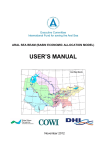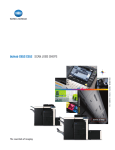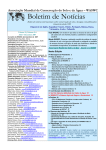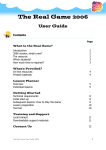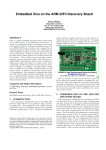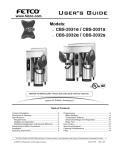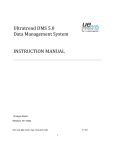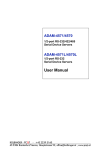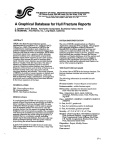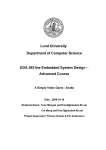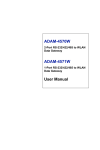Download The Ferghana Valley 2035 Simulation Exercise User Guide
Transcript
The Ferghana Valley 2035 Simulation Exercise User Guide November 2013 Acknowledgements This guide has been developed by Charlotte Crabtree, Humanitarian Futures Programme. The simulation initiative would not have been possible without generous support from the Australian CivilMilitary Centre, Deloitte Touche Tohmatsu Limited, and the World Food Programme. Their support and advice have been invaluable. Guide outline The document that follows is intended to provide a practical guide to those who wish to explore, prepare for and undertake the simulation. Rather than step-by-step instructions, the document should be read as adaptable guidelines, the components of which can be modified and scaled up or down according to the stakeholders and resources available. Contents Part 1: Simulation Overview 2 Part 2: Objectives 4 Part 3: Simulation Design 5 Part 4: Simulation Case Study 8 Part 5: Implementation Guidelines 13 Part 1: Simulation Overview The Humanitarian Futures Programme humanitarian roles and responsibilities will have to look to the respective expertise of those in sectors such as the military and private sector. Since 2005, the Humanitarian Futures Programme (HFP) at King’s College London, has worked to act as a catalyst to create awareness of the changing types, dimensions and dynamics of future humanitarian crises. In so doing, it has attempted to raise awareness across ‘traditional’ and ‘nontraditional’ humanitarian actors of the need to strengthen capacities to anticipate emerging threats and identify capacities that are needed to manage widening vulnerability and increasing humanitarian demands The Humanitarian Capacities Challenge The global community is faced with an everexpanding number of humanitarian threats - their dimensions and dynamics growing in many instances exponentially. The significant challenges faced by foreseeable crises such as pandemics, cybernetic failures, and mega tsunamis are predicted to interact with more conventional crisis drivers such as climate change and natural hazards. Those with humanitarian roles and responsibilities will increasingly lack the capacities and resources needed to deal with such threats, and the implications of these emerging gaps will have significant impact upon the lives and livelihoods of untold numbers around the world – East, West, North and South – this presents a significant humanitarian capacities challenge. In order to prepare for humanitarian futures, far greater collective attention will have to be given to anticipating future risks and opportunities to mitigate them. Greater emphasis will have to be given to developing longer-term strategies and promoting more agile and adaptive organisational response. Innovation and innovative practices will be essential to promote resilience and sustainability as well as more effective and appropriate crisis response. With such plausible threats, humanitarian action needs to be both underpinned by new forms of partnerships and strengthened through the use of more innovative practices to ensure that the capacities and resources are in place to prepare for and respond to such threats. As means to address future threats and opportunities, those with While the engagement of these actors in humanitarian action is not new, there remains both deep scepticism about their roles, particularly in the response phase, and a fundamental lack of understanding about how to sustain more effective interaction in the longer term to support more effective prevention and preparedness. Traditionally, both sectors are recognised for their roles in response; the private sector for its philanthropy and corporate social responsibility; and, the military, predominantly for its operational support. Deeply embedded misunderstanding about objectives, priorities and measures of success and fundamental differences in culture or ‘institutional DNA’ present major challenges to effective cross-sector collaboration. The need to build a greater understanding of how ‘traditional’ and ‘non-traditional’ actors could interact or interface more effectively is essential. This includes a greater appreciation of the comparative advantages each might offer for more effective across all aspects of humanitarian prevention, preparedness, response and post-crisis recovery. ‘Sim-in-a-box’: The Simulation as a Tool to Support Cross-Sector Collaboration Over the past eight years HFP has worked closely with a wide range of partners internationally across the military, humanitarian, and private sectors; the government and international organisations; and academic and scientific communities, in an effort to demonstrate how a range of capacities from ‘nontraditional’ humanitarian actors can enhance the ways that the international community, including ‘traditional’ humanitarian actors can prepare for and respond to the growing number and types of future humanitarian crises. Amongst others, the recurring conclusion has been that both a fundamental lack of understanding about sectoral culture, or ‘institutional DNA’ and misunderstandings about objectives and priorities, present critical challenges to effective cross-sector collaboration -- the sort of collaboration that has the potential to support more effective humanitarian action. There is lack of initiatives that focus on supporting more effective cross-sector collaboration across the military, humanitarian and private sectors. While initiatives to simulate humanitarian crises to test established protocols and build capacities are not new, they have a tendency to focus predominantly on response training amongst ‘traditional’ humanitarian actors. Indeed, while the military and the private sector also have established and varied simulation mechanisms to support internal learning and capacity building, systematic mechanisms which bring together actors beyond what it is considered the ‘traditional’ humanitarian sector are very limited. This in part can be explained by the fact that traditionally diverse objectives and priorities as well as deeply embedded stereotyping and mistrust have all too often resulted in a fundamental lack of understanding between ‘traditional’ and ‘nontraditional’ actors. In response to the humanitarian capacities challenge and to support more effective humanitarian action, cross-sector boundaries must be overcome. All too often, the discussion around what capacities different sectors might have to offer are either overlooked or hidden by stereotyping. In addition to this, the humanitarian sector is essentially response-orientated and all too often fails to anticipate plausible or potential longer term threats and to prepare for them in a coherent, strategic manner - very few simulation mechanisms force participants to consider their capacity within a futures context. To overcome the barriers that inhibit effective humanitarian collaboration, HFP, with the support of partners, has explored a range of potential tools to respond to this lack of understanding and has developed a methodology designed to demonstrate ways that different actors can identify their added value-addeds and comparative advantages. Using futures based simulation methodology, the 2035 Humanitarian Capacity Challenge simulation offers ‘traditional’ and ‘non-traditional’ humanitarian actors means to bring to the fore the sorts of expertise, innovation, and human and in-kind resources needed to deal with the sorts of catastrophes one can anticipate in the future. It is designed to demonstrate how the challenges the humanitarian sector will face in the future will require the sorts of capacities that ‘non-traditional’ actors can contribute with respect to strategic thinking, innovative practices and expertise. More importantly, it seeks to promote future interaction and collaboration across ‘traditional’ and ‘nontraditional’ humanitarian actors. Part 2: Objectives The simulation’s overarching objective is: To demonstrate how a range of capacities from ‘non-traditional’ humanitarian actors can enhance the ways that the international community can prepare for and respond to the growing number and types of future humanitarian crises. iii. iv. The specific objectives of the exercise are: advantages in light of potential transformation changes; and To encourage them to consider how they might respond to such evolving crises in a changing global context; Prior to the simulation, it is advised that participants take part in a short futures or horizon-scanning workshop in order to ensure they have sufficient scaffolding for the futures mind set required. 1. To identify capacities that can strengthen humanitarian action; Target audience 2. To determine the extent to which differences in sector language, terminology, objectives, priorities, and measures of success pose a constraint to participants in identifying such capacities; 3. To itemise participants’ respective comparative advantage and value added in regards to humanitarian action; and 4. To agree on mechanisms by which the results of these tests can be reviewed, improved and implemented. Why 2035? The importance of a futures perspective Guided by an increasing recognition that the kinds of crises we will have to face in the future will be increasingly complex in type, dimension, and dynamic, the Humanitarian Capacities Challenge simulation exercise is intentionally set 20 years into the future in order: i. ii. To remove participants from their institutional and sector perceptions or ‘comfort zones’; To get participants to relate their potential value-addeds and comparative With the simulation objectives in mind, the exercise is broadly aimed at the following target audience: - - The humanitarian sector: International non-governmental organisations (INGOs), Non-governmental organisations (NGOs), and international institutions such as the UN; the military; the police force; the government; and the private sectors: multi-national, national and local. That said the exercise is intended to be adaptable and accommodate different stakeholders depending upon the context. Part 3: Simulation Design Overview of simulation structure The Ferghana Valley simulation is intended to be an adaptable and scalable tool according to the stakeholders involved and resources available. What follows outlines the design and structure of the simulation exercise including details on each phase, its specific objectives, phase tasks and what will be described as interventions. The Humanitarian Capacities Challenge (HCC) simulation is intended to last for 1½ days. Day One consists of an overview briefing including a horizon scanning exercise and three phases, namely, precursor, prompter and perfect storm. Day Two involves a half-day debriefing exercise. Each of the three phases is designed to test different capacities and components of prevention, preparedness and response in humanitarian action. Participants should be divided into mixed sector teams and taken through a scenario in the Ferghana Valley between Kyrgyzstan, Tajikistan and Uzbekistan, in which a major multinational corporation wishes to assess the region for establishing a major parts division for outer space exploration. [i] Overview Briefing & Futures Workshop Ahead of the simulation, participants should be invited to attend an overview briefing session and futures workshop. The overview briefing provides organisers with an opportunity to brief participants on the exercise proceedings, and the futures workshop allows organisers to ensure that participants are sufficiently grounded in a ‘futures mind set’ – a critical element of the success of the simulation itself. It is advised that the futures workshop comprise of futures orientated exercises such as horizonscanning to initiate discussion about the key trends (a discernable pattern of change) and drivers (factors that cause or directly influence change) that will affect the wider context in which humanitarian action will take place in the future and the system in which it will have to operate. Through facilitated discussion, participants should be encouraged to explore trends and drivers, and risks and opportunities related to geo-politics, technology, the environment, social and demographic affairs, and economics. It is recommended that the overview take place the afternoon and evening before the exercise. [ii] Phase 1: Precursor To identify different approaches to identifying vulnerabilities and resilience; In the first phase, precursor, a futures world is explored in a seemingly stable state. The assignment in the precursor context will be to assess the resilience capacity of the region under review. In other words, participants will be asked to identify strengths and weaknesses of the region in terms of economic, social and political stability and growth potential. The overarching intention of phase 1 is to observe how different sets of participants (e.g. military, humanitarian, private sector) would respond and identify potential strengths, weaknesses, opportunities and threats, depending on their respective professional backgrounds. [iii] Phase 2: Prompter To determine perceptions of potential crises, to see how different sets of participants prioritise them and generate contingency plans; In the prompter phase, humanitarian crisis threats are not evident, but nevertheless identifiable symptoms or undercurrents of potential ‘discontinuities’ can be detected. Hence, in the second phase of the exercise, there is growing evidence of a range of possible hazards that might lead to one or more major humanitarian crises. The overt impacts of such hazards have not been felt as yet, but their possible existence as well as means to mitigate their effects does require greater concentration on a contingency plan – the output of the prompter phase. The overarching intention of phase 2 is to examine the differences in sector approaches to identifying such potential threats, and contingency plan. [iv] Phase 3: Perfect storm To deal with a highly complex humanitarian crisis in ways to demonstrate the contributions that each sector might make towards a crisis response, the sorts of priorities that each establishes and the possibility that a coherent, integrated approach might evolve; The final phase, perfect storm, introduces a complex catastrophe. The contingency plans that should emerge out of phase 2 might well address some of the threats, but a variety of interventions during the course of phase three may well introduce factors for which participants might not have been able to anticipate. In that sense, the final phase is intended to capture the ways that participants respond to the complexities of an ever-changing crisis. While each phase is designed in such a way to meet the specific objectives described above, the underlying objective through all three phases is to identify the ways in which the differences that emerged across sectors are or are not overcome in order to respond to the tasks given in each phase. [v] Debriefing Session At the conclusion of the phase 3, facilitators should review initial observations and findings and reconvene participants the following day. Fundamentally, the debriefing exercise provides facilitators and participants with a neutral space for reflection on the opportunities and recommendations presented during the simulation, which have the potential to improve professional practice into the future. Specifically it offers participants an opportunity to take part in an intensive review of the implications of the simulation to determine the ‘language,’ value-addeds and comparative advantages that different groups of participants offered during the exercise. It should offer participants an opportunity to identify and review how lessons-learned can be developed further to strengthen ways that the international community responds to ever more complex humanitarian crises. Phase Tasks: As outlined in the phase overview, participants will be required to undertake a series of tasks within each phase. Each task is designed to assess how the different sectors deal with and respond to different questions related to different components related prevention, preparedness and response. Hard copy templates should be prepared for each task and participants are required to nominate a representative from their team to record observations and answers to each question posed. Interventions In addition to a series of tasks within each phase, it is recommended that interventions be introduced throughout the exercise as a means of driving the scenario. Interventions or injects can be used by the simulation organisers as a catalyst to provoke a response or reaction from participants. They can also be used as a means of reorientation when participants or particular sectors became too comfortable or optimistic in the scenario. The timing of the interventions should correspond to the dynamics of discussion observed by the control team through either the instant messaging stream or silent observation e.g. should participants be dealing well with the phase tasks, the control team may wish to introduce a complex intervention. Interventions can be prepared in a range of formats but must be based upon assumptions about forms of media in 2035. The interventions were designed to have positive or negative effects on undertaking tasks and some are focused on a particular sector in order to draw them out of their ‘comfort zone’. Base Documentation Participants should be provided with copies of the case study background or base documentation. This document should provide participants with essential information specific to the scenario case study including geo-politics, the environment, economics, and social and demographic issues. The documentation should also include essential information pertaining to Omnilever including its business objectives, core values, financial status, and an inventory of where it is established and assets it has at its disposal. This document should be used us by participants as a primer to allow them to more readily act as employees of the co-operation. operation. Data Capture Methodology data capture mechanism can be adjusted and organisers may choose to have the expert control liaison play a duel role of liaison and expert panel. Real time participant team transcription: Via instant messaging e.g. Skype or Microsoft Lync, the control team liaison in each team room can provide a real time transcription of both the key points in discussion, and the dynamics and body language of the team. Expert Panel as Silent Observers: Instant MessagingData Stream Expert Panel as Silent Observers To support the debriefing component of the simulation,, as part of their role, members of the expert panel should be instructed to act as silent observers in the team rooms. Expert Panel De-briefing: briefing: Expert Panel Debriefing Participants Debriefing Following each phase, the expert panel should be convened for a short 10-15 15 minute de-briefing de and feedback session. Based upon their observations made through their roles as silent observers and examining the instant messaging data stream, this activity will allow for the capture of initial findings and observations The control team support can provide a transcription ription of the key discussion points. Participants De-briefing: briefing: o support the learning component (both for the To organisers and the participants) of the simulation, it is designed to incorporate te a variety of mechanisms to maximise opportunities for capturing data across both the participants and the control team. Each aspect of data capture is designed to allow for the control to team to identify initial observations and findings according the simulation objectives, and in so doing, complement and support the debriefing phase. The essence of this design is to allow organisers to adapt mechanisms for data capture to meet their needs e.g. should the recommended number for the control team not be available, a the Participants can then be invited to provide feedback in a half-day day session on Day 2 of the simulation. The debriefing stage, therefore, will enable participants to have a better understanding understandin about the language used by each set of participants, the ways that they see their respective roles, responsibilities and interests and the value-addeds addeds and comparative advantages they each bring to the three phased scenario. From this shared experience, participants as well as facilitators and observers should be able to direct participants to where there are common interests and opportunities for more systematic and consistent collaboration. Part 4: Simulation Case Study The Ferghana Valley Case Study The Ferghana Valley Case Study: Overview The Ferghana Valley case study that follows is the template scenario offered to organisers. The case study itself can be adapted depending on the regional context, or indeed, can be based upon a fictional country or region. Should the organisers choose to adapt the case study, it is nevertheless recommended that the following crisis drivers be incorporated into the scenario in order to provide participants with a futures-orientated complex and multi-dimensional crisis situation. It is, therefore, suggested that the scenario incorporate the following crisis drivers: • Complex historical antecedents including ethnic conflict • New forms of technologies and technological failure e.g. cybernetic failure & artificial intelligence • Complex vulnerabilities, including those resulting from slow and rapid onset natural hazards and technological interaction. Should organisers choose to adapt the Ferghana Valley case study outlined here, a background document and summary should be prepared and given to participants in advance of the simulation exercise. The case study, as noted earlier, is fictional and futures-orientated. It is based on a hypothetical geopolitical situation, the substance of which can be transposed to any other geographical setting. The main features of the Ferghana Valley simulation are that: i. ii. iii. A major multinational corporation, Omnilever, has identified a multibillion dollar opportunity to invest in the burgeoning economies of Central Asia. The cost of investment requires an intense multidimensional analysis of the risks and opportunities of investing in this complex region; The basis of the company’s investment is to establish a facility that can produce high technology equipment and parts for a global market, which includes China, Iran and Russia; The multidimensional analysis has to take into account not only the region’s present capacities in terms of technological expertise, wealth and infrastructure, but also its iv. v. historical antecedents including ethic and deep cultural differences; The multidimensional analysis will also have to consider that, despite the seeming modernity of its infrastructure; there are weaknesses in some aspects of its infrastructure, e.g. a dam essential for hydroelectric power controlled controlle via cybernetic systems; Dealing with these issues in three different phases may lead to different analyses of those specialists undertaking the multidimensional analysis. Those specialists – fired by Omnilever – come with perspectives that reflect their respective military, humanitarian and commercial backgrounds. Case Study Summary routes for oil importation, saw Central Asian resources as providing a compelling logistics alternative. Not only did it, therefore, invest heavily in extraction of oil and other her natural sources, but it also expended significant sums on new transportation routes for carrying those resources to China and ensuring flows of Chinese goods into the Central Asian markets. China had by 2017 become the second largest trading partner throughout th Central Asia, and was well on its way to threatening Russia’s economic dominance. The fate of Central Asia until the mid-2020’s mid was dominated by its neighbours, and, in much the same way, the fate of those same neighbours was influenced significantly tly by key trends in the wider world. These trends in turn rebounded upon Central Asia. In a period renown for remarkable innovation and geo-political political change, there were at least four factors globally that dramatically influenced the fate of Central Asia byy the 2030’s: Agricultural innovation: st Arising out of the remnants of the post-Cold post War Empire of the Soviet Union a group of Central Asian states has emerged that bears little resemblance to its Soviet antecedents. dents. For over seventy years, Soviet areas of Central Asia had seen much industrialisation and construction of infrastructure but also the suppression of local cultures, hundreds of thousands of deaths from failed collectivisation programmes, and a lasting g legacy of ethnic tensions and environmental problems, the latter including the dumping of over 800 million tonnes of radioactive and toxic waste. Now almost fifty years after the end of the Cold War, the states of Central Asia, Kazakhstan, Kyrgyzstan, Tajikistan, ajikistan, Turkmenistan and Uzbekistan, have become symbols of extraordinary commercial opportunities. Rapid growth in the demand for hydro-carbons carbons and other natural resources in the early 2020’s, had tempted China, India and Iran to engage more extensivelyy in Central Asia. China in particular, concerned about its dependence upon sea Much of the early years of the 21 century were haunted by the spectre of food insecurity. With a global population rapidly rising beyond 8.8 billion, there were clear indications that food availability could soon become ‘an existential risk.’ Although the global food situation seemed ever more fragile, the prospects were not all bad. Agricultural technology went through a series of paradigmatic changes, which in turn altered the face of agriculture, and subsequently ly transformed much of the barren steppes of the CSA into a booming bread-basket bread for some of its neighbours and others outside the region. The explanation for this agricultural transformation lies, to a very significant extent, in a spurt of highly sophisticated ticated technologies from 2024 onwards. During the early 2000s, Israeli techniques had increasingly become a model for those who had similar shortages of productive land and limited water supplies. Combined with such techniques and rapid developments related relat to biotechnology, robotics, nanotechnology and satellite monitoring, agriculture in ‘the Stans,’ as the five states were labeled, quadrupled in volume. This increase not only provided for most domestic requirements in the region, but also provided at least le 19% of all basic food commodities for India, Iran and China. Demand for Water: Water as a commodity rose in value exponentially, and in some instances, water traded at a higher value than hydrocarbon fuels, as exemplified in trade between Canada and the United States. Its availability to rural as well as urban populations was at times dangerously low as evidenced by rapidly declining water tables. The consequences of declining availability had to be seen in the context of what had been described by a leading consultancy group as a ‘negative multiplier,’ a damaging chain reaction not only affecting human needs and agriculture, but also resulting in large scale degradation of land and soil. Yet, as is all too evident today, governments continue to feel compelled to look at water in terms of its power-generation capacities, and have focused upon dam construction rather than on alternative forms of water management. The reason for this choice is clear -- governments still feel hydropower projects are integral to planned capacity development. Despite the major breakthroughs in nuclear fusion technology, dam construction remains a core source of energy, and some governments have justified this continuation because of its dual function, namely, energy and water resources for agriculture. Nowhere is this more evident than in South Asia where dam construction up through 2028 accounted for between 20% and 100% of all expansion; Resource and supply conundrum: Many of the key assumptions about resource requirements and available supplies proffered in the st early part of the 21 century have maintained their relevance into the 2030s. During the last century, unprecedented numbers of people lived in conditions of increasing affluence, and most of those who did not, aspired to do so. Certainly over the past 35 years the world has witnessed an unprecedented surge in resource prices – as predicted -- and this in part includes food, water and to a decreasing extent, fossil fuels. Even more dramatic, however, are the cost of materials required to maintain the momentum of rapidly emerging technologies. The innovations that have allowed for the capturing of the Earth’s magnetic fields and the power of the sun have been wide-ranging, and in turn they required manufacturing processes and raw materials that were not in the mainstream a decade before. A significant growth in space flights for commercial purposes, for example, now requires far lighter and more resilient metals for engines, and the minerals needed for these metals are mainly found in Central Asia, western China and the desert areas of SubSaharan Africa. Artificial intelligence and cybernetics: In the spheres of both artificial intelligence and cybernetics, the international community has seen an unprecedented rise of new and improved innovations, many of which have been described as ‘transformational.’ However, all too often governments and responsible authorities have failed to appreciate fully not only the positive benefits of these innovations but also the challenges involved in managing them. Nevertheless, in the Americas, throughout Africa, Asia, Europe and the Antipodes, the compulsion to take advantage of innovations to lower costs, to maximise production and, wherever possible, to enhance social benefits was a feature of the 2030’s. And yet, it has been generally accepted with general sanguinity that cybernetic processes – a precursor in many ways of artificial intelligence -- have for all intents and purposes replaced many functions that even 50 years before were clearly reliant upon direct human intervention. Studies in the early 2010s highlighted the vulnerability of many systems throughout the world to what had been described as a ‘minor collision of a small portion of an asteroid with a satellite in outer space.’ Banking and logistics, manufacturing and communications, all became dependent upon cybernetics. Virtually all systems – from cash transfers to the control of sluice gates for major dams and village-based hydroponics – had then and continue to be dominated by cyberneticbased technology. Emerging Opportunities: The Ferghana Valley in 2035: If there is any place in Central Asia that reflects the impact of these global trends, it is the Ferghana Valley. The valley has always been the most fertile, densely populated region in the whole of Central Asia. Straddled by three countries -- Kyrgyzstan, Tajikistan and Uzbekistan – it, like much of Central Asia, has benefitted from the agricultural and mineral demands of a world undergoing a determined search for resource and supply stability. This search is, in effect, driving, in various ways, the geo-politics not only of Central Asia’s neighbours but the wider international community as well. While the demographic impact of Central Asia’s growth has been felt mainly in the capitals of the five states, extensive ‘urban settlements’ in the valley clearly suggest the region’s emerging prosperity. These settlements have been the result of tens of thousands of people from rural areas ready to benefit from the employment opportunities connected to agricultural and mining and to private and public support services. The mix of urban settlers is from many parts of Central Asia, though principally from Kyrgyzstan, Tajikistan and Uzbekistan. While reflecting their respective countries’ different cultural, religious and ethnic groupings, their overall focus during the past five years of prosperity continues to be on the advantages of employment. That said, there is no doubt that wages and prices have over the past year and a half been on an upward spiral that has been difficult for the respective governments to control. This clearly is an issue as well for the communities that are located in neighbouring states within the valley. Feint attempts had been made in the capitals to establish an interstate trading association, but there has been relatively little political interest to push this forward. The general consensus remains that independent growth and opportunities have led to increasingly prosperous communities, each determined to maintain their cultural, religious and ethnic identities without at the same time threatening prosperity. One of the drivers for this success has been the resources of the vast Kyrgyzstan’s Toktogol dam and reservoir which today provides significant though varying degrees of energy and water resources for the five states, and certainly for the communities within the valley. The Toktogul is literally and figuratively the ‘valve’ of the valley and much beyond, and has doubled in size and quadrupled in carrying capacity since it was first constructed in the mid-1970s. The reservoir has a total capacity of 24.5 cubic kilometers, and its length is 65 kilometres. The maximum depth of the reservoir is 128m (420 ft.), and it feeds the Toktogul hydroelectric station, presently producing over 2800 MW, with its four turbines generating over 700 MW each. That volume is enormous even in comparison with similar systems elsewhere, but at the same time has caused some analysts to express concerns about the fragile fault lines that intersect the valley. Comparisons have been made with other seismically fragile regions where the sheer volume and weight of reservoirs have triggered seismic faults. Those along the Himalayan waters of ‘the Third Pole’ are potential cases in point, and the earthquakes that resulted in 2008 and 2013 in China’s Sichuan province, resulting in the deaths of hundreds of thousands, are seen as evidence enough. And yet, despite these concerns, the significance of the Toktogul dam goes beyond such threats and even its economic benefits. It was the centerpiece of the Soviet Union’s efforts to conquer nature in that same way almost half a century later. When it became fully operational in the late 1980s, the project to control the region’s rivers seemed complete, particularly with the Integrated Water Resource Management Project (IWRM) that ensured technical management for water regulation and control for all the users. However, the IWRM and its subsidiary bodies may hide but does not necessarily resolve the fundamental political nature of water management. The Ferghana Valley as an investment opportunity Nevertheless, the valley on the whole is seen as rich with opportunities for those who are looking for commercial investments in the centre of a burgeoning economic zone. As in the days of Marco Polo some eight centuries before, the steppes of Central Asia and, in particular the Ferghana Valley, could play a significant role in fuelling major economic development across continents. Companies with vision are increasingly aware of such potential. One such company is the major global corporation, st Omnilever. Omnilever, at the beginning of the 21 century, was regarded as one of the top multinational corporations in the world. A series of brave initiatives in products well outside its ‘traditional’ scope of activities, particularly in space and cyber-related investments, resulted in growth and expansion, that set it apart in terms of wealth, reach and influence -- well beyond most of the top 50 multinational corporations. It was seen as a truly global company. While some of those brave initiatives that transformed Omnilever in the earlier part of the century were highly risky and ‘brave,’ the company is more than aware that in today’s market its every move is now scrutinised not only by commercial organisations, but also by governments and international organisations. Omnilever has become the litmus test for sound investments and economic growth. Any major move that the company makes is analysed around the world. Omnilever, aware of its status, recognises that before it commits to investment in the valley, it will have to be very sure about the risks and opportunities that the valley offers. With that in mind, Omnilever will be sending a senior level delegation to Central Asia towards the latter part of 2035 to review all aspects of the investment initiative. Before doing so, however, it intends to send a team of world experts to undertake a comprehensive analysis of the region to be sure that its interest in the Ferghana Valley is warranted, particularly in light of the anticipated $112 billion expenditure. ‘We need to be sure,’ stressed Omnilever’s President and Chief Executive Officer, ‘that the soundness of our investment meets not only the expectations of our shareholders, but also those in the international community who are not insensitive to the implications of Omnilever’s investment decisions.’ With that in mind, an integrated assessment team of 183 specialists – social scientists, security analysts and natural scientists – are to join a highly experienced group of commercial analysts, ranging from logistics and infrastructure specialists in manufacturing processes and commercial communications to assess potential sites in Central Asia for the Omnilever initiative, with particular attention to the Ferghana Valley. The assessment team will soon be arriving for what is assumed will be a two week preliminary mission. Part 5: Implementation Guidelines This section on Implementation Guidelines suggests how the Ferghana Valley simulation exercise can be organised and operated. In proposing these guidelines, facilitators will inevitably wish to adjust implementation details according to their available resources and time as well as available participants and intended objectives. Whatever the particular variations in the approach to this futures-oriented simulation, the following are factors that should be taken into account in any approach to this initiative: the facilitation and participant teams – composition and roles, running of the simulation, and the equipment and materials needed. Facilitation and Participant Team Guidelines The guidelines that follow outline both facilitation team and the optimal number of participants and representatives from the humanitarian, military and private sectors that should comprise the simulation exercise’s 5 participant teams. That said, the guidelines are based upon the best possible scenario and resources available. They should be interpreted as guidelines and adapted according to the resources available. Participant Teams It is recommended that organisers seek participants from the military, humanitarian and private sectors to take part in the simulation exercise. The matrix below outlines how participants should be divided up into groups based upon best case scenario, maximum and minimum Figure 1: Facilitation and Participant Team Guidelines The blue team should be comprised of humanitarian sector only, the yellow team of humanitarian and military, the green of military and private sector, the teal of humanitarian and private sector and the purple of humanitarian, military and private sector. Comprised of solely the humanitarian sector, the blue team should be viewed as the ‘control team’, via which comparisons can be drawn against mixed sector groups and the subsequent differences demonstrated in approaches to the prevention, preparedness and response phases of the simulation exercise. Participants should not be informed of their assigned groups until Day One of the simulation exercise. Should organisers be unable to reach this number, the ratios of participants according to sectors should be roughly based upon the following guidelines: Participants Team Composition Resource Guidelines Maximum Resources Minimum Resources TOTAL NUMBER 30 60 17 Humanitarian Sector 13 Private Sector 8 Military 8 Blue: Humanitarian 5 INGO, NGO mix 6 3 Military 3 Private Sector Yellow: Military/Private Sector Green: Humanitarian/Military Teal: Humanitarian/Private Sector Purple: Humanitarian/Private Sector/Military INGOs, NGOs Local, national, international National, international 6 3 Humanitarian 3 Military 6 3 Humanitarian 3 Private Sector 6 2, Humanitarian 2 Private Sector 2 Military 26 7 16 5 16 5 10 3 12 3 12 3 12 3 12 5 Blue Team: Humanitarian Sector Purple Team: Humanitarian/ Military/ Private Sector Teal Team: Humanitarian/ Private Sector Yellow Team: Military/ Private Sector Green Team: Humanitarian/ Military Participant Roles In order to fully engage with the simulation, organisers should brief participants on what it means to be an Omnilever employee and that they have been selected as an employee based upon their actual expertise and experience, which they should draw upon during the simulation. Facilitator Team Composition and Roles The facilitation team should include the following participants detailed in the table below. The table includes a brief outline of the recommended roles of each member of the facilitation team. It should be noted, however, that this team is scalable according to the resources available. To ensure the facilitation team are fully briefed on their roles and the exercise objectives, organisers should hold at least one full team briefing ahead of the simulation. This can be carried out in person, over the phone or Skype, or through a video-conferencing facility. Running the Simulation It is advised that the lead facilitator and and control team lead, direct the proceedings for the duration of the exercise. Both these roles and the roles of the other members of the facilitation team outlined above will be supported by guidelines set out in the facilitator’s handbook (which accompanies accompanies this user guide). The handbook provides a detailed overview of the following elements of the simulation: the objectives; the proceedings; phases 1-3, 3, the corresponding tasks for each phase; the interventions; and debriefing templates. The following slides ides are taken from the facilitator’s handbook, is an example from phase 1 of the simulation and includes the tasks (and the task template for questions 1 and 2) that should be given to the participant teams. Using the facilitator’s handbook, the organisers organisers can create a participant’s handbook, which should contain replications of the phase backgrounds, tasks, and templates slides. The following table provides guidance on the agenda and timings for Day 1 of the simulation. It is the role of the Control Team Lead to be responsible for keeping time and communicating this to the rest of the facilitation and participant teams. The agenda and timings can be adapted according to the time available but organisers should allow at least 1.5 hours for each phase and 30 minutes for the presentation of tasks. Time Description 08:30 – 09:00 Coffee and registration 09:00 – 09:30 Welcome and Initial Briefing 09:30 – 11:30 Main simulation 11:30 – 12:30 Working lunch – Green team briefing to CEO Phase 1 Precursor Working lunch – Teal team briefing to CEO Working lunch – Purple team briefing to CEO Working lunch – Yellow team briefing to CEO Working lunch – Blue team briefing to CEO 12:30 – 14:00 14:00 – 14:30 Main simulation Phase 2 Presentation to CEO Representative and submission of phase task 14:30 – 15:00 Coffee break 15:00 – 17:45 Main simulation Phase 3 Submission of presentation task 17:45 – 18:00 Day round-up Equipment and Material Guidelines In its essence, the simulation is designed to be an adaptable tool, which meets the needs of a variety of stakeholders, and as such, the guidelines for materials that follows has intentionally been designed to reflect this need for flexibility. Equipment The list that follows can be adapted or scaled up or down according to resources (e.g. should internet be unavailable) the number of facilitators could be increased to allow for relay of key information from the participant team rooms to the control team. Equipment Example of adaption to suit resources Laptops If limited IT resources available, control liaison can take hand written notes and an additional silent observer could relay key messages back to the control team at 10/15 minute intervals? x 5 for each participant team x 2/3 for control team LCD projector x 1-2 for control team Flip charts Not a necessity, draft paper can be used and fixed onto the wall x 6 for participant and control team Printer for hard copies of the materials Necessary requirement for printing of simulation materials. That said, the quantities and qualities of materials can be scaled down, and external suppliers used depending on resources available Stationery Supplies pad & pen per participant, post-it notes Wireless Network Connection Should a wireless network be unavailable, Printing Guidelines The printing guide below details the materials produced for the first and second iterations of the Ferghana Valley Simulation exercise. The documentation necessary for any given future iteration of the exercise will be dependent on scale and scope of the exercise and of course, on whether organisers choose to adapt or change the scenario case study. Indeed, the quantity and quality of printed documents can be adapted to suit budget and resources available. That said, it should be noted that the preparation of documentation will require substantial input and preparation from the organising team, and therefore it is advised that the lead time reflects this. Document Quantity Size Bound Details Facilitator Pack 12 A4 Y Approx. 40 pages double sided, 1 for each of the control team Participant Pack Green team 5 A4 Y Approx. 8 pages Double sided, 1 for each participant Participant Pack Yellow team 5 A4 Y Approx. 8 pages Double sided, 1 for each participant Participant team Teal 5 A4 Y Approx. 8 pages Double sided, 1 for each participant Participant Pack Purple team 5 A4 Y Approx. 8 pages Double sided, 1 for each participant Participant team 5 A4 Y Approx. 8 pages Double sided, 1 for each participant Name badges for drinks reception and pre-briefing (without team colour) As per number of participants N/A N/A Name badges for day 1 and day 2 (with team colour) As per number of participants N/A N/A Participants List Distribute on the day 40 A4 N Room lay-out generic 7 A4 N N/A Manning rota 12 A4 N N/A Simulation format 12 A4 N N/A Base Documentation 12 A4 N Approx.20 pages double sided, 2 for each team, 2 for control team Base Documentation Interventions (Sit Reports) 12 A4 N Approx. 5 pages double sided, 2 for each team, 2 for control team Ferghana Valley Case Study Full Background 12 A4 N Approx.20 pages double sided, 2 for each team, 2 for control team Ferghana Valley Case Study Summary Background 12 A4 N Approx.20 pages double sided, 2 for each team, 2 for control team (this will also be included in the participants packs and facilitators packs) Phase 1 – 3 Injects 15 copies of the whole document A4 N Single sided, colour, 1 for each participant team & 10 for the control team Pack Pack Blue to Document Quantity Size Bound Details Phase 3 Additional Injects 15 A4 N For control team Phase 2 Summary & Tasks 30 A4 N To be given to each team at the beginning of phase 2 Phase 3 Summary & Tasks 30 A4 N To be given to each team at the beginning of phase 3 Templates Phase 1 12 A3 N Single sided, colour, A3, participant teams to fill in for Templates Phase 2 12 A3 N Single sided, colour, A3, participant teams to fill in for Templates Phase 3 12 A3 N Single sided, colour, A3, participant teams to fill in for Debriefing templates 12 A3 N Single sided, colour, A3, participant teams to fill in for 10 A3 N Posters with information key FV Humanitarian Futures Programme King’s College London Virginia Woolf Building 22 Kingsway London WC2B 6NR +44 (0)20 7848 2869
























